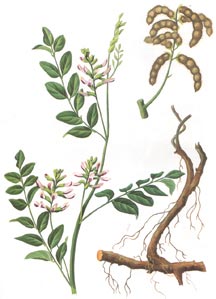Licorice is very popular in the winter time taken as a tea with other herbs to help relieve sore throats, coughs, stomach aches, and help boost the immune system. Just the thought of curling up on a cold fall or winter day with a cup of licorice tea may have a calming and peaceful effect on the mind and body!
Licorice root is one of the most commonly used herbs in traditional Chinese medicine. Used to help harmonize the effects of other herbs and prolong their effect. In the United States ninety percent of the licorice that in imported is used to flavor and sweeten tobacco.
Today licorice is often seen as a candy, however, that delicious candy is often not flavored with licorice at all but with anise and fennel! So don’t count on that candy having any healing value (except for maybe subduing that sweet tooth)! Licorice root is fifty times sweeter than sugar, often used as a sweetener that can be safely consumed by most diabetics.
There are about twenty species of licorice native to Eurasia, Australia, and North and South America. It is often found in the wild in grassy areas where the soil is more alkaline. Licorice can be cultivated and worked into the soil to enrich it.



MATERIA MEDICA: LICORICE
Latin Name: Glycyrrhiza glabra (European Licorice), G. inflata, G. lepidota (American Licorice), G. uralensis (Chinese Licorice)
Family: Fabaceae (Pea Family)
Parts Used: Root
Actions: Adrenal tonic, alterative, antacid, anti-arthritic, anti-bacterial, anti-fungal, anti-inflammatory, antimutagenic, antioxidant, antiseptic, antispasmodic, antitumor, antitussive, anti-venomous, antiviral, aperient, aphrodisiac, chi tonic, demulcent, emollient, expectorant, febrifuge, galactagogue, hepatoprotective, immune tonic, laxative (mild), lung tonic, nutritive, pectoral, phytoestrogenic, rejuvenative, sedative, sialogogue, tonic.
Key Constituents: Anethole, glycyrrhizin, isoflavones, polysaccharides, volatile oils, starch, amino acids, phytosterols, coumarins (Chevallier, 2000; Hoffmann, 2003).
Preparation and dosage:
- Tea: 2 tsp. to 12 oz of boiling water, steep for 5-15 minutes, depending how sweet you want your tea. Or add to your favorite tea blend for a bit of sweetness!
- For those hot summer days boil 7 cups of water add ¼ cup of peppermint tea and steep for 10 minutes, add 2 tsp of licorice root and steep for another 5 minutes (again depending on how sweet you would like your tea). Pour into a many mason jars or a large one and refrigerate. When ready to drink add a few sprigs of peppermint, drink and enjoy.
- Tincture: 10 drops - 1 mL 3-4 times/day as recomnedded by your herbalist
- Licorice root may also be taken in tablets, in hair rinses to help prevent hair loss and dandruff, in lotions and salves for eczema, psoriasis, shingles, and wounds. Licorice can be made and used as a mouthwash for tooth decay, gingivitis, and mouth sores.
Uses: acid indigestion, Addison’s disease, adrenal weakness, age spots, Aids, alcoholism, allergies, arthritis, asthma, bladder infections, bronchitis, bursitis, cancer, candida, carbuncles, catarrh, chronic fatigue, cirrhosis, colds, constipation, cough (dry), debility, depression, diarrhea, dropsy, dyspnea, dysuria, eczema, Epstein-Barr virus, emotional instability, emphysema, fatigue, fever, gallbladder inflammation, gastritis, gout, Grave’s disease, hair loss, hay fever, heartburn, hemorrhoids, hepatitis, herpes, HIV, hives, hoarseness, hypoglycemia, hysteria, immune system weakness, infertility (male and female), irregular ovulation, irritability, irritable bowel, laryngitis, Lyme disease, menstrual cramps, Parkinsons disease, pharyngitis, poisoning (from food or chemicals), prostatitis, psoriasis, shortness of breath, sore throat, stomach ache, stress, tendonitis, thirst, tuberculosis, tumors, ulcers, underweight conditions, and wheezing
Cautions:
Written by apothecary intern Risa Palmer
- Chinese licorice is said to be less likely to cause side effects than the European licorice. Licorice is often added in very small amounts to herbal teas to unify them, add a bit of sweetness, and to help prevent undesired side effect.
- Avoid licorice in cases of high blood pressure, edema, nausea, vomiting, and rapid heartbeat. Long term use with large doses may elevate blood pressure, cause headaches and vertigo.
- Large doses may cause sodium retention and potassium depletion.
- Licorice root is not recommended during pregnancy or in combination with steroids or digoxin medication.
- Continuous use is not recommended for more than six weeks.
- The deglycyrrhized extract (which has had the glycyrrhizin removed) is safe to use, and has no side effects; however, if using licorice as an antiviral, the deglycyrrhized extract will be ineffective



